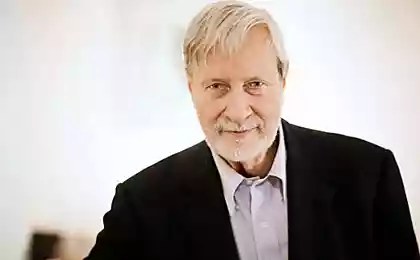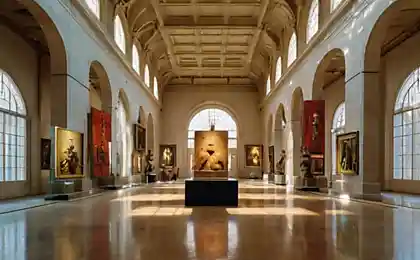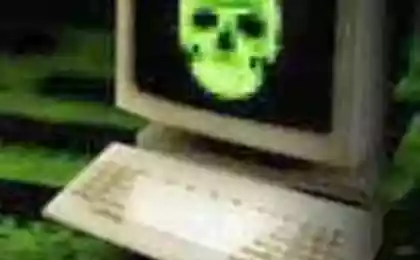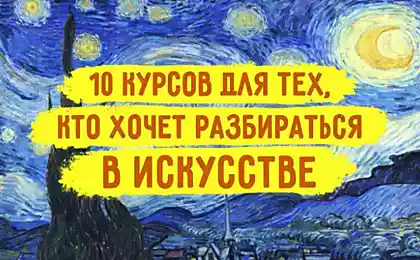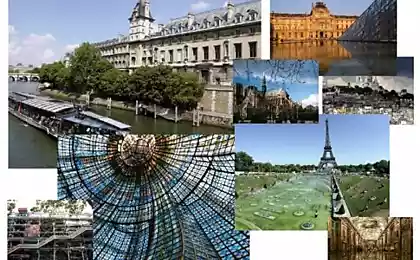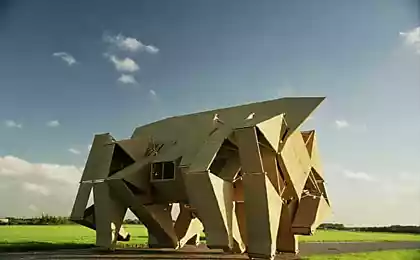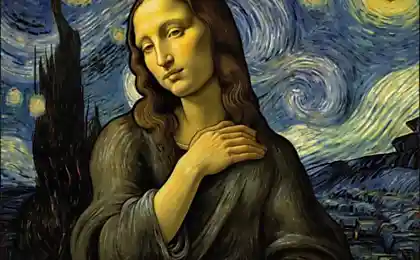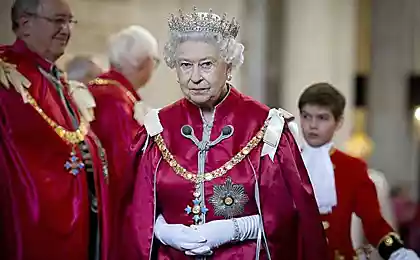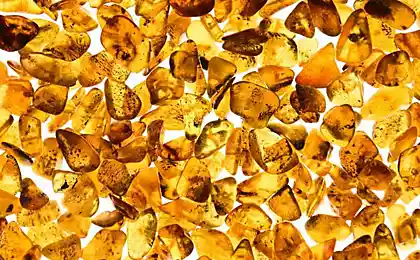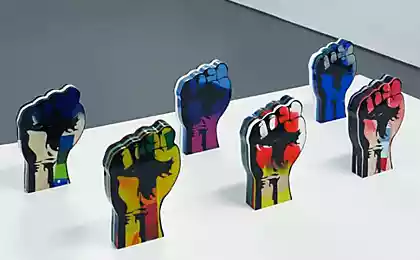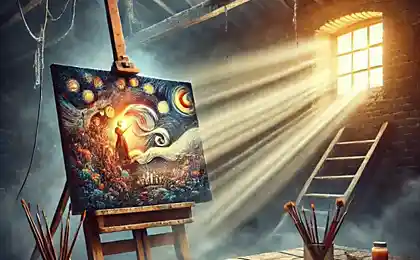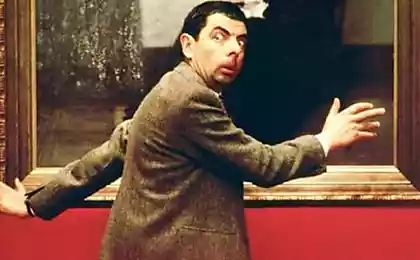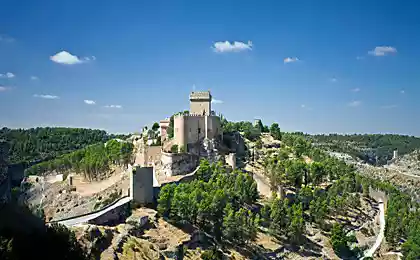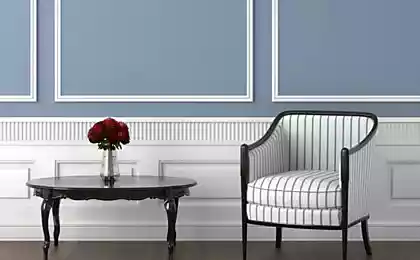1089
Secrets of ancient works of art
As it turned out, a lot of works of medieval masters stored in a hidden message and unsolved mysteries. Read an interesting review further.
Once again I wonder at how steep documentaries made on the BBC. And even more surprisingly, they are not released on DVD his series «imagine», which is already in 1983 and tells about the art and everything connected with it. And there is a series of adjacent «omnibus». Here and this time caught the two-part film - David Hockney: Secret Knowledge (David Hockney's «Secret Knowledge»). Hockney is very famous in the world of British artist who is engaged in all forms - from painting to photography. But he is also a man who has a bunch of curiosity.
One day he looked at the drawings of Jean Auguste Dominique Ingres (Jean Auguste Dominique Ingres) - these were figures of British tourist in Rome. Ingres was the leader of the French academic school of the XIX century, and Hockney just was curious to see his little drawings on a larger scale and it has increased them by Xerox. And so he came to a secret party in the history of painting, starting with Renaissance.
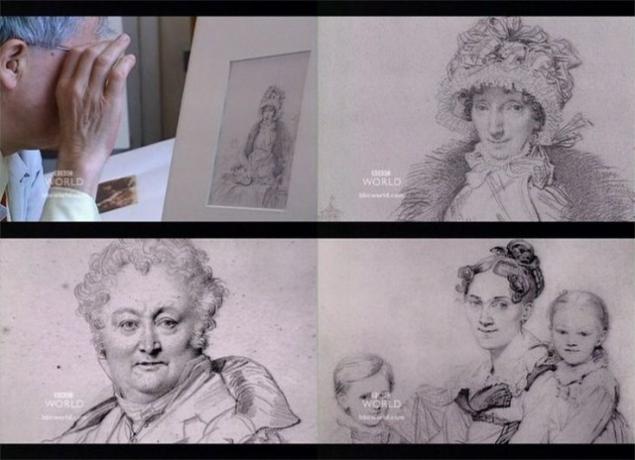
Make a photocopy of the small (about 30 centimeters) of drawings by Ingres, Hockney was amazed at how much they are realistic. And it seemed as if the line of Ingres it something resemble. It turned out that they remind him of the work of Warhol. A Warhol did so - projected image on the canvas and depicts it. Like here, for example, the figure of Mao Zedong on the right and the left part of Ingres drawing.
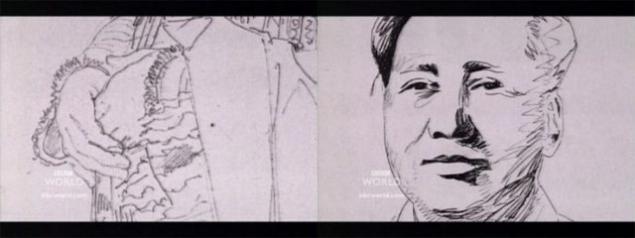
Interesting case, says Hockney. Apparently, Ingres used the Camera Lucida - a device that is a structure with a prism, which is attached at the front to the plate in such a way that the artist, looking at his picture, sees with one eye real image, and the other - the actual figure and his hand. The resulting optical illusion accurately transferring a proportion of the real image on the paper. What is the "pledge of" realism.
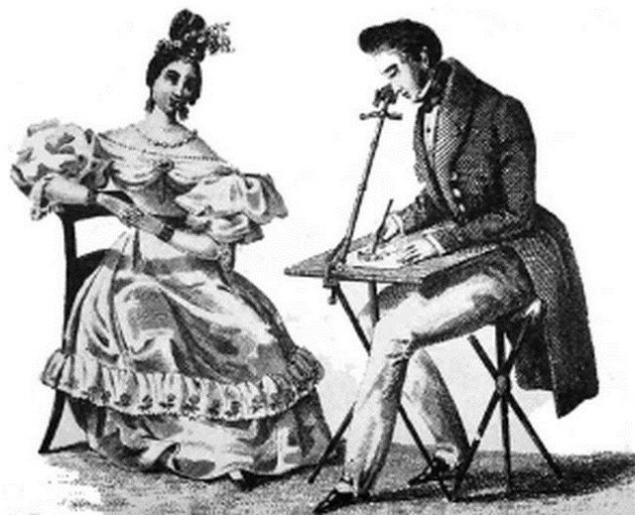
Then Hockney was seriously interested in this "optical" view drawings and paintings. In his studio he and his team hung on the walls of hundreds of reproductions of paintings created over the centuries. Works that looked "real" and those who did not look. Located at the time of creation, and regions - north top, south at the bottom, Hockney team saw a sharp break in the painting at the turn of 14-15 centuries. Well, it's to everyone who knows a little bit about the history of art, it is known - the Renaissance. And, according to the official history of art, about 1420's all of a sudden become a much better draw ...
That is, it's as though it goes without saying that all of a sudden, everything suddenly took happened. When I was in my artistic institutions that have never really thought about it, because there were not so many draft beers and student life was not easy ...
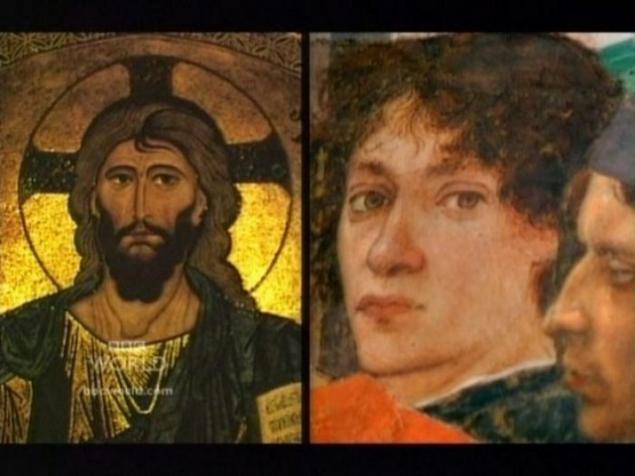
Maybe they used that same camera lucida? It was patented in 1807 by William Hyde Wollaston. Although, in fact, such a device is described by Johannes Kepler in 1611 is still in his work Dioptrice. Then they can be used by other optical devices - the camera obscura? She had known since the days of Aristotle and a dark room in a small hole through which the light falls, and thus, in a dark room turns the projection that the front of the hole, but upside down. All anything, but the image, which is obtained by projection of the pinhole camera without a lens, to put it mildly, poor, it is not clear, it requires a lot of bright light, not to mention the size of the projection.
But the quality of the lens it was almost impossible to make up to the XVI-century, since it does not exist at the time, ways to get high-quality glass. Cause-and thought Hockney, by that time had bivshy on the problem together with the physicist Charles Falco.
However, there is a picture Jan Van Eyck - Master of Bruges, Flemish painter of the early Renaissance, - in which the hidden clue. The painting is called "Portrait of Arnolfini».
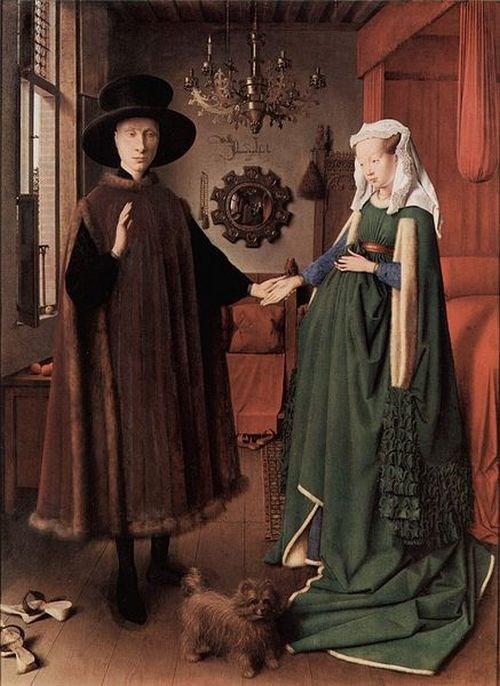
Painting well, just shine a surprising number of details, which is quite interesting, because it was written back in 1434. And tips on how the author managed to make such a big step forward in realism, is a mirror.
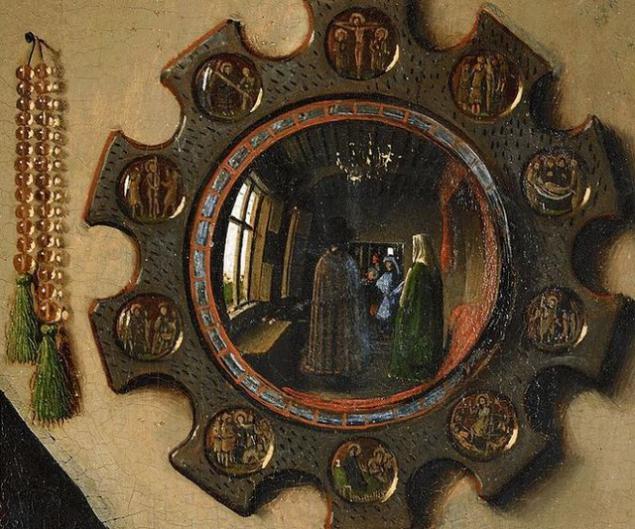
And the candlestick - an incredibly complex and realistic.
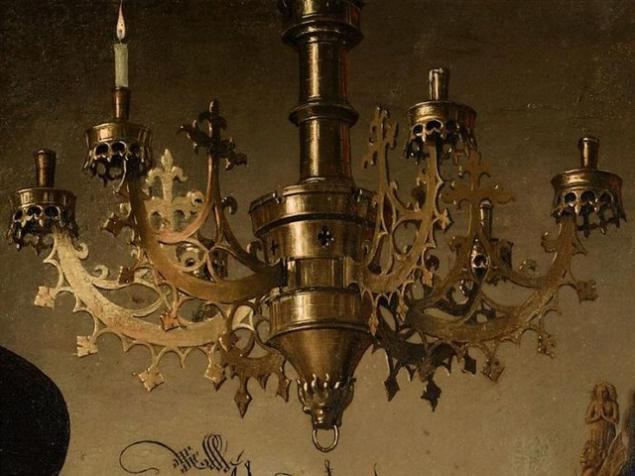
Hockney - artist and as it was bursting with curiosity, he got hold of a copy of a chandelier and tried to draw her. He was faced with the fact that this is not a complicated thing will draw in perspective. Another important point was the materiality of the image of some metal object. When the image of the subject steel is very important to arrange the glare as much as possible really, since it attaches great realism. But the problem with these reflections is that they move when moving the viewer or the artist to capture them at all easy. And realistic image of metal and glare - is also a distinctive feature of the paintings of the Renaissance, before the artists did not even try to do that.
At the same time, in 1435, Albert, architect and theorist of Florence, describes in his book on the art device for accurately transferring image - frame within which is located a grid that allows you to measure the proportions of nature on the square and on the squares of the same, carried in drawing. Using such a device is extremely difficult and that is important - frame, you can use only one point in space, that is to paint only part of the image, and only from one location.
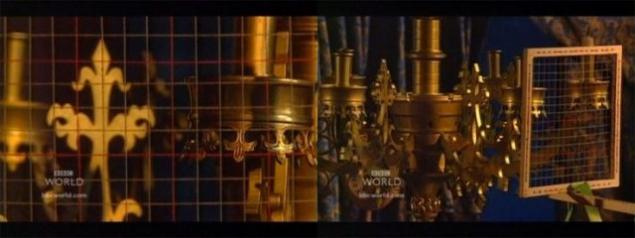
Restore an exact three-dimensional model chandeliers, Hockney team was convinced that the chandelier in the painting "Arnolfini Portrait" painted the exact term one vanishing point. But the problem was that such precision optical instruments like a camera obscura with a lens did not exist about a century after the creation of the painting.
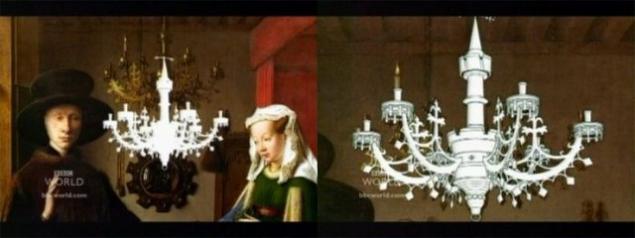
Tip solving the puzzle is the fact that the paintings of the Renaissance suddenly appears bright, contrast and volumetric sunlight. This is especially evident in the paintings of Van Eyck - and he lived in the north, in Bruges.
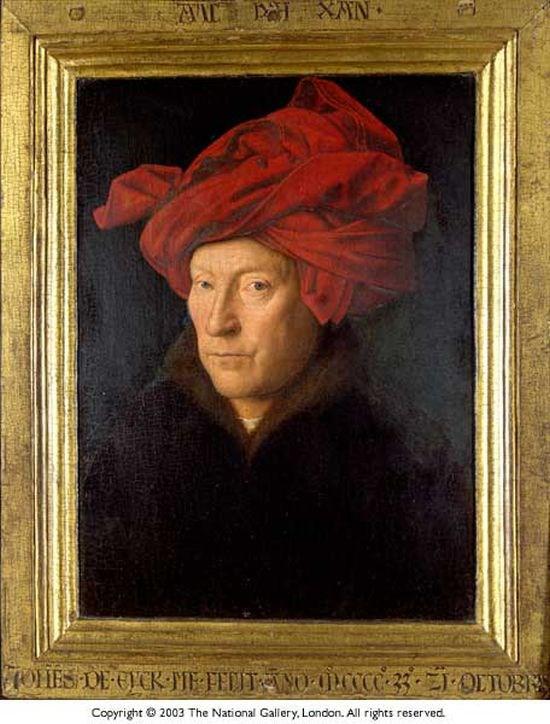
And on the details of the portrait visible constricted pupils pose - so he sat in bright sunlight.

But if you go back to "Arnolfini Portrait", there can be seen a mirror. In the larger fragment shows that the convex mirror. So were the mirror opposite - concave. Even more so, in those days, such mirrors were made in such a way - was taken glass sphere, and its bottom covered with silver, then all but the bottom cut off. The back side of the mirror does not dim. So concave mirror Jan Van Eyck could be the very mirror that depicted in the picture, just the reverse side. And any physicist knows that the mirror is the reflection of the reflected image projects. Here the calculations and research and helped his friend David Hockney physicist Charles Falco. The concave mirrors have been known since ancient times, they were called mirrors to burn, it is considered that Archimedes used it to burn enemy ships.
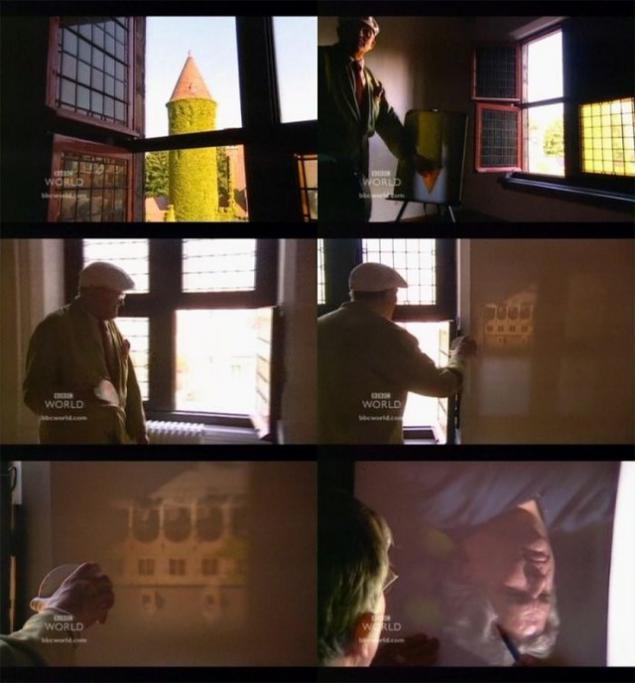
Size clear, focused projection of the approximately 30 square centimeters - and this is just the size of the head on the set of portraits of the Renaissance. This is for example the size of the portrait "of the Doge Leonardo Loredana" authorship Giovanni Bellini (1501), Portrait of a male authorship Kempina Roberto (1430), actually a portrait by Jan van Eyck's "Man in a Red Turban" and yet many of the early Dutch portraits.
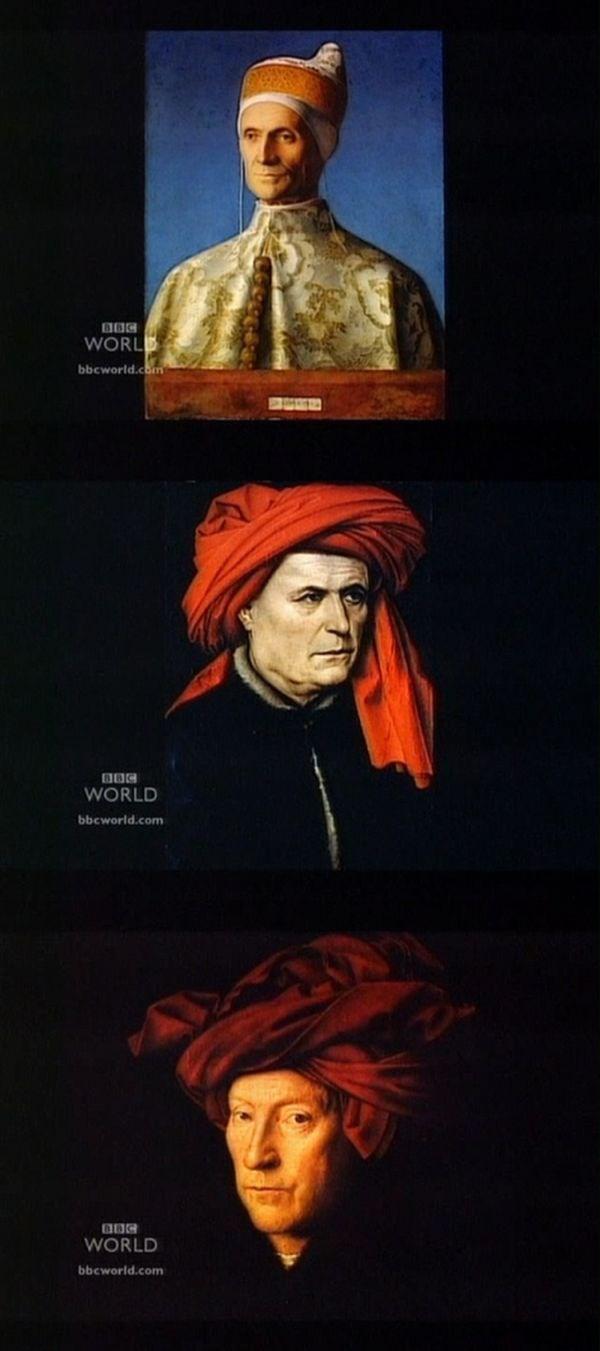
And, of course, all these guys were not fools to go and tell their secrets everywhere - in fact a painter - a work, a lot of money. Jan van Eyck never wrote down his formula of varnishes and paints - apparently he did not want them to fall into the wrong hands. The perfect time of the Renaissance is known that, in addition to the rise of Art, at the time were great contests for orders and could easily slaughter. It turns out that for the artist much more profitable if all uninitiated people will assume that the secret of mastery - in the hands of their masters, and not to steal. Business!
And, of course, this business has been closed to outsiders - the artists were in the guild, in the same as those which consisted variety of masters - those who have done the saddle, to those who did the mirror. And in the Guild of St. Luke (Guild of Saint Luke), based in Antwerp, and was first mentioned in 1382 (then like guild opened in many northern cities and one of the largest was the guild in Bruges - the city where he lived, Van Eyck) were also masters to make mirrors.
And now Hockney recreated in what way you can draw a complex picture of a chandelier with Van Eyck.

It is not surprising that the projected size of the chandelier today coincides exactly with the size of the chandelier in the painting "Arnolfini Portrait" - eight inches in width. And, of course, reflections on metal - now on the projection, they stand still and do not change when the artist changes the position.
Finally I would also like to show a full pardon, blade head. Cloth Hans Holbein the Younger authorship "after." It was written in 1533! And it - an optical illusion - a joke Holbein, a human skull, an image so that it will be visible in the long term only if a normal approach to the painting side and casual look at it ...
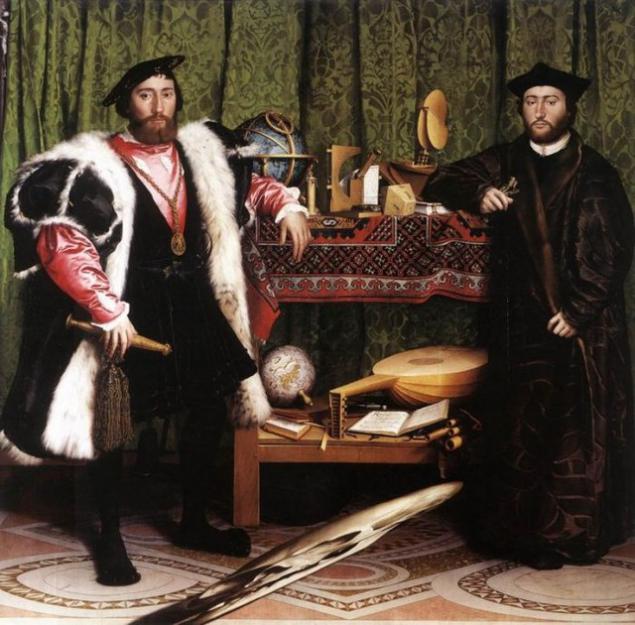
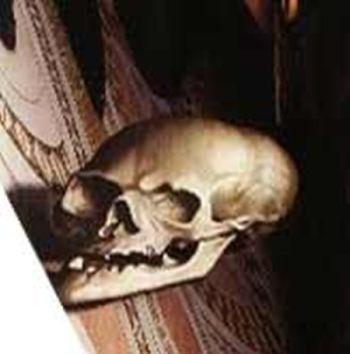
Once again I wonder at how steep documentaries made on the BBC. And even more surprisingly, they are not released on DVD his series «imagine», which is already in 1983 and tells about the art and everything connected with it. And there is a series of adjacent «omnibus». Here and this time caught the two-part film - David Hockney: Secret Knowledge (David Hockney's «Secret Knowledge»). Hockney is very famous in the world of British artist who is engaged in all forms - from painting to photography. But he is also a man who has a bunch of curiosity.
One day he looked at the drawings of Jean Auguste Dominique Ingres (Jean Auguste Dominique Ingres) - these were figures of British tourist in Rome. Ingres was the leader of the French academic school of the XIX century, and Hockney just was curious to see his little drawings on a larger scale and it has increased them by Xerox. And so he came to a secret party in the history of painting, starting with Renaissance.

Make a photocopy of the small (about 30 centimeters) of drawings by Ingres, Hockney was amazed at how much they are realistic. And it seemed as if the line of Ingres it something resemble. It turned out that they remind him of the work of Warhol. A Warhol did so - projected image on the canvas and depicts it. Like here, for example, the figure of Mao Zedong on the right and the left part of Ingres drawing.

Interesting case, says Hockney. Apparently, Ingres used the Camera Lucida - a device that is a structure with a prism, which is attached at the front to the plate in such a way that the artist, looking at his picture, sees with one eye real image, and the other - the actual figure and his hand. The resulting optical illusion accurately transferring a proportion of the real image on the paper. What is the "pledge of" realism.

Then Hockney was seriously interested in this "optical" view drawings and paintings. In his studio he and his team hung on the walls of hundreds of reproductions of paintings created over the centuries. Works that looked "real" and those who did not look. Located at the time of creation, and regions - north top, south at the bottom, Hockney team saw a sharp break in the painting at the turn of 14-15 centuries. Well, it's to everyone who knows a little bit about the history of art, it is known - the Renaissance. And, according to the official history of art, about 1420's all of a sudden become a much better draw ...
That is, it's as though it goes without saying that all of a sudden, everything suddenly took happened. When I was in my artistic institutions that have never really thought about it, because there were not so many draft beers and student life was not easy ...

Maybe they used that same camera lucida? It was patented in 1807 by William Hyde Wollaston. Although, in fact, such a device is described by Johannes Kepler in 1611 is still in his work Dioptrice. Then they can be used by other optical devices - the camera obscura? She had known since the days of Aristotle and a dark room in a small hole through which the light falls, and thus, in a dark room turns the projection that the front of the hole, but upside down. All anything, but the image, which is obtained by projection of the pinhole camera without a lens, to put it mildly, poor, it is not clear, it requires a lot of bright light, not to mention the size of the projection.
But the quality of the lens it was almost impossible to make up to the XVI-century, since it does not exist at the time, ways to get high-quality glass. Cause-and thought Hockney, by that time had bivshy on the problem together with the physicist Charles Falco.
However, there is a picture Jan Van Eyck - Master of Bruges, Flemish painter of the early Renaissance, - in which the hidden clue. The painting is called "Portrait of Arnolfini».

Painting well, just shine a surprising number of details, which is quite interesting, because it was written back in 1434. And tips on how the author managed to make such a big step forward in realism, is a mirror.

And the candlestick - an incredibly complex and realistic.

Hockney - artist and as it was bursting with curiosity, he got hold of a copy of a chandelier and tried to draw her. He was faced with the fact that this is not a complicated thing will draw in perspective. Another important point was the materiality of the image of some metal object. When the image of the subject steel is very important to arrange the glare as much as possible really, since it attaches great realism. But the problem with these reflections is that they move when moving the viewer or the artist to capture them at all easy. And realistic image of metal and glare - is also a distinctive feature of the paintings of the Renaissance, before the artists did not even try to do that.
At the same time, in 1435, Albert, architect and theorist of Florence, describes in his book on the art device for accurately transferring image - frame within which is located a grid that allows you to measure the proportions of nature on the square and on the squares of the same, carried in drawing. Using such a device is extremely difficult and that is important - frame, you can use only one point in space, that is to paint only part of the image, and only from one location.

Restore an exact three-dimensional model chandeliers, Hockney team was convinced that the chandelier in the painting "Arnolfini Portrait" painted the exact term one vanishing point. But the problem was that such precision optical instruments like a camera obscura with a lens did not exist about a century after the creation of the painting.

Tip solving the puzzle is the fact that the paintings of the Renaissance suddenly appears bright, contrast and volumetric sunlight. This is especially evident in the paintings of Van Eyck - and he lived in the north, in Bruges.

And on the details of the portrait visible constricted pupils pose - so he sat in bright sunlight.

But if you go back to "Arnolfini Portrait", there can be seen a mirror. In the larger fragment shows that the convex mirror. So were the mirror opposite - concave. Even more so, in those days, such mirrors were made in such a way - was taken glass sphere, and its bottom covered with silver, then all but the bottom cut off. The back side of the mirror does not dim. So concave mirror Jan Van Eyck could be the very mirror that depicted in the picture, just the reverse side. And any physicist knows that the mirror is the reflection of the reflected image projects. Here the calculations and research and helped his friend David Hockney physicist Charles Falco. The concave mirrors have been known since ancient times, they were called mirrors to burn, it is considered that Archimedes used it to burn enemy ships.

Size clear, focused projection of the approximately 30 square centimeters - and this is just the size of the head on the set of portraits of the Renaissance. This is for example the size of the portrait "of the Doge Leonardo Loredana" authorship Giovanni Bellini (1501), Portrait of a male authorship Kempina Roberto (1430), actually a portrait by Jan van Eyck's "Man in a Red Turban" and yet many of the early Dutch portraits.

And, of course, all these guys were not fools to go and tell their secrets everywhere - in fact a painter - a work, a lot of money. Jan van Eyck never wrote down his formula of varnishes and paints - apparently he did not want them to fall into the wrong hands. The perfect time of the Renaissance is known that, in addition to the rise of Art, at the time were great contests for orders and could easily slaughter. It turns out that for the artist much more profitable if all uninitiated people will assume that the secret of mastery - in the hands of their masters, and not to steal. Business!
And, of course, this business has been closed to outsiders - the artists were in the guild, in the same as those which consisted variety of masters - those who have done the saddle, to those who did the mirror. And in the Guild of St. Luke (Guild of Saint Luke), based in Antwerp, and was first mentioned in 1382 (then like guild opened in many northern cities and one of the largest was the guild in Bruges - the city where he lived, Van Eyck) were also masters to make mirrors.
And now Hockney recreated in what way you can draw a complex picture of a chandelier with Van Eyck.

It is not surprising that the projected size of the chandelier today coincides exactly with the size of the chandelier in the painting "Arnolfini Portrait" - eight inches in width. And, of course, reflections on metal - now on the projection, they stand still and do not change when the artist changes the position.
Finally I would also like to show a full pardon, blade head. Cloth Hans Holbein the Younger authorship "after." It was written in 1533! And it - an optical illusion - a joke Holbein, a human skull, an image so that it will be visible in the long term only if a normal approach to the painting side and casual look at it ...


What you can rent a house in Moscow for $ 600
Positive images and funny pictures on the list of the day
